Hello from Montreal: Exploring Montreal’s History with the Old Montreal Walking Tour
Every time I go to a new city, the spirit of adventure and discovery heightens my energy level and 6:10 am I was already awake. I read my guidebook for a while and then doze off again, only to be awakened by a major thunderstorm that drenched the city with a downpour. So I got up and enjoyed a leisurely breakfast and by 9:30 or so things had calmed down again, just in time for my explorations of the city. The Old Montreal Ghost Tour last night had already given me a bit of an overview of the old historic centre of Montreal and introduced me to some interesting characters.
Five minutes from my hotel is the Place d’Armes, one of Montreal’s most famous squares. The old part of the city was still quiet, and I enjoyed a peacefull stroll through the cobble-stoned streets. I headed into one of Montreal’s Tourist Information Office, located right at the southwest corner of Rue Notre Dame and Place Jacques Cartier to stock up on maps and ask various questions of the helpful staff.
Old Montreal in the morning has such a European feel to it, with the little cafés just setting up shop and local residents getting ready to walk to work. The calm relaxed atmosphere contrasts quite sharply with the usual frenetic hustle and bustle that we are so used to in our North American metropolitan cities.
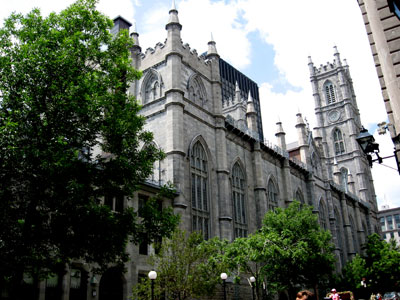
Gothic Revival splendour at the Basilica of Notre Dame
After a relaxing walk that allowed me to admire the architecture and the narrow streets and alleyways I returned to Place d’Armes where my Old Montreal Walking Tour, provided by licensed tour guides from Guidatour, would be starting at 11:00 am. The meeting place was just outside the Notre-Dame Cathedral and our two tour leaders were already waiting. Our English-speaking group would be handled by Louis while the French-speaking group was entrusted to another guide, Bruno.
Eleven of us tourists congregated around Louis and in his charming French accented yet perfect English he started to educate us about the history and architecture of Old Montreal, adding a dose of subtle humour. Naturally our tour started with the Basilica of Notre Dame, probably Montreal’s most visited building. Louis took us inside the basilica and we discovered that the C$15 admission ticket for the walking tour actually covers the $4 that the Basilica charges for admission.
The Basilica of Notre Dame is a magnificent Gothic revival church, designed ironically by the Protestant Irish-American architect James O’Donnell who had also designed churches in New York City, and built between 1824 and 1829. In addition to a stunning Gothic revival exterior, Notre Dame features a dramatic interior, with a deep blue ceiling that is decorated with golden stars. It is one of the most unusual churches I have seen and its visual impact is stunning.
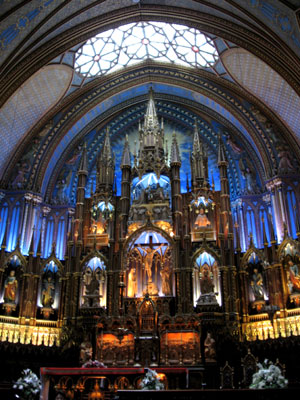
The amazing interior of the Basilica
Louis explained to us that for about Can$2000 you can get married in this church, but obviously there is a waiting list of at least two years. Celebrities like Quebecois singer Celine Dion and hockey great Mario Lemieux got married here. Notre-Dame Basilica was also the location of former prime minister Pierre Elliot Trudeau’s funeral, Canada’s most well-known prime minister. Louis then took us through the side chapel out into the wedding chapel, officially called “La Chapelle Notre-Dame du Sacré-Coeur” which unfortunately was seriously damaged in a fire in 1978. Much of the woodwork has been reconstructed in a more modern style, but the chapel is still an impressive space.
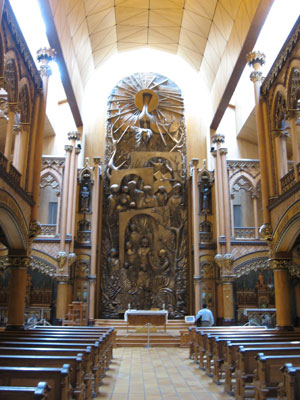
The Wedding Chapel
After our first introduction to Montreal architecture we walked westwards just a few steps on Rue Notre-Dame and had a look at Montreal’s oldest building: the Old Seminary or “Vieux Séminaire Saint-Sulpice”. Built in 1683 by Sulpician priests, this building used to be a manor from which the priests managed their vast land holdings. During the early years of Montreal’s history, the town’s citizens were exposed to frequent attacks by the Iroquois, and the Old Seminary represented a refuge in a place that was still mostly wilderness. The characteristic public clock was installed in 1701 and is among the oldest such timekeepers in all of North America.
We then stopped to admire Place d’Armes, right in front of the Basilica, so called because it used to be a location for military manoeuvres as well as for religious processions. Place d’Armes is a veritable collection of architectural history. The New York Insurance building, dating back to 1888, was the first building to install the newly invented elevator, at the time making it the highest building in all of Montreal. The Hotel Place d’Armes just north, originally five stories high, actually had three stories added once the building was retrofitted with an elevator.
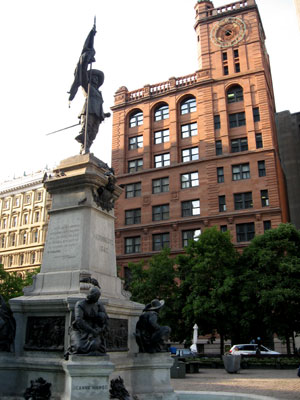
Place d’Armes with the New York Insurance Building
The Aldred Building is a fine example of Art Deco skyscraper architecture and for many years it was the highest building in Montreal. Louis quite appropriately referred to the stepped back skysraper design as the wedding cake architectural style. The centre of Place d’Armes is watched over by a statue of Paul de Chomedey, Sieur de Maissoneuve, who founded Montreal in 1642.
The north end of Place d’Armes holds another architectural marvel: the Bank of Montreal building. Founded in 1817 as the first bank in Canada, the Bank of Montreal decided to build an impressive headquarters in 1847 and created a neoclassical exterior modeled after the Roman Pantheon. The interior was completely redesigned in 1904 to 1905 by the famous New York architectural firm of McKim, Mead and White with a magnificent banking hall modeled after a Roman basilica.
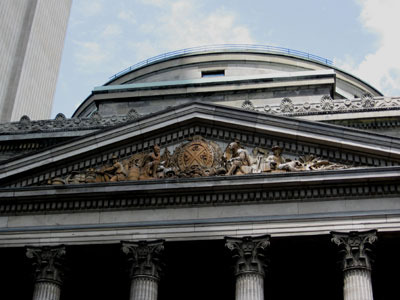
Frieze on the Bank of Montreal Building
Heading west of St. James Street (or rue St-Jacques), Louis explained that this used to be Canada’s business centre during the 19th century. Many Canadian banks had their headquarters here until they were moved into downtown Montreal or later to Toronto. Railway and shipping companies also had their head offices here, many of them founded by immigrants from Scotland.
The architectural mix on rue St-Jacques is impressive and Louis pointed out one example that has recently been renovated and reincarnated as the extremely upscale St. James Hotel. This trendy boutique hotel offers a penthouse suite that can be rented for around $5000 a night (in low season) and it is a favourite hangout of celebrities. To mention just one example, Madonna just stayed at the St. James recently at the end of June during her Montreal concert stop.
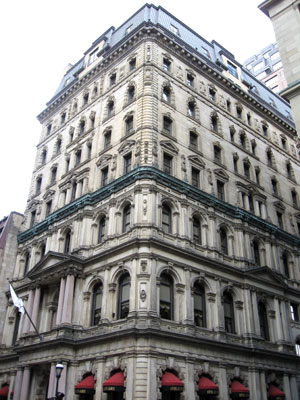
The recently restored boutique hotel St. James
Another truly impressive architectural jewel came into view: the former head office of the Royal Bank, whose construction began in 1928 according to designs by famous New York skyscrapers experts York and Sawyer. For a long time this building was the largest in the British Empire. The design is influenced by a Florentine palazzo and the impressive high ceilings of the Great Hall feature the coats of arms of eight of Canada’s ten provinces.
Unfortunately no photography was allowed in either the Bank of Montreal or the Royal Bank buildings, but they are astounding examples of architectural styles of different eras. Louis then took us through the narrow streets of Old Montreal towards the city’s waterfront and the birthplace of the city. As a major port town and shipping centre, many of the buildings in Old Montreal were warehouse buildings featuring large windows to let in a lot of natural daylight. This was to reduce the risk of fire that would have been caused by artificial lighting at the time, putting at risk the precious cargo that these buildings were storing.
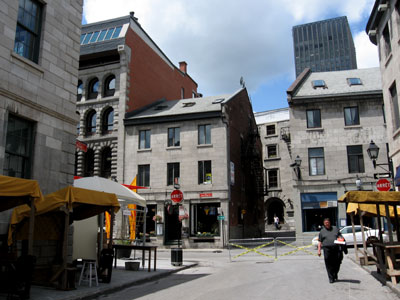
Old Montreal on a gorgeous day
I kept asking Louis numerous questions about the architecture and social history of Montreal. His knowledge of architecture was impressive, and to compare architectural styles, he was referencing numerous other well-known buildings in other cities such as New York City, Toronto, Boston and Chicago. He mentioned that a lot of historic buildings were torn down in Montreal during the 1960s as in so many other North American cities, but fortunately the architectural preservation movement gained strength and today all of Old Montreal is protected.
Old Montreal languished for a number of decades since most of the action had moved downtown, but in the last fourty years Vieux Montréal has experienced a revival that started with the major international event of Expo 67. Today, many of these former warehouse buildings have been converted into upscale condos and Louis informed me that even a small studio apartment will probably fetch a price tag of at least half a million dollars. Old Montreal has made a successful transition from a former commercial district to a vibrant tourism, entertainment and residential area.
Close to the waterfront we arrived at Place d’Youville, an elongated public space that is located on the former riverbed of the Rivière Saint-Pierre that was canalized in the 1830s and eventually covered over and dried out completely. The History Centre of Montreal is a former fire station and a rare example of Flemish architecture in Quebec.
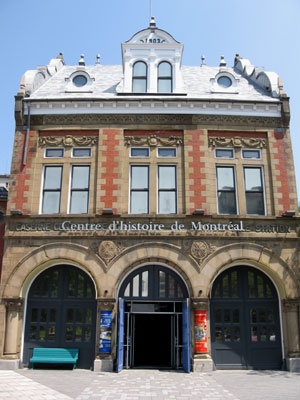
Montreal’s History Museum, a former fire hall
Just a few steps east is Montreal’s Museum of Archeology and History at Pointe-à-Callière. It is very rare to know exactly where a city was founded, but Montrealers know exactly where their city first came into being: on a narrow strip of land between the St. Lawrence and the Saint-Pierre River. Right there the first settlers built Fort Ville-Marie, using earth and wooden posts. As a matter of fact, on May 17, 1642, Father Vimont held a mass celebrating the founding of Montréal, attended by Sieur de Maisonneuve, Jeanne Mance and some of the other founding colonists.
Today, the museum consists of six buildings and introduces visitors to the city’s history in the most innovative ways. There is even an archeological dig here, unearthing further knowledge about the city’s history. Various festivals including a multicultural festival and a historic market weekend are also held a Pointe-à-Callière.
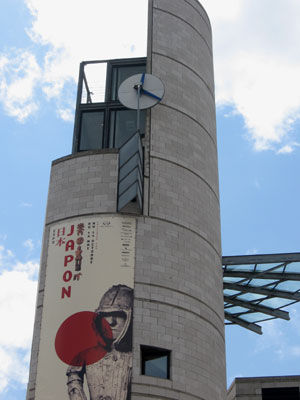
Pointe-à-Callière, Montreal’s Museum of History and Archeology
Our route then took us back up to Notre Dame Street. The former Palais de Justice, built between 1849 and 1856, is a fine example of Canadian neoclassicism. Today the building houses the Quebec Court of Appeal. Across the street is the Ernst Cormier Building, opened in 1926 and named after the famous architect that also designed the main pavillon of the Université de Montreal as well as the doors of the United Nations Headquarters in New York City.
Our tour through Old Montreal appropriately came to an end at Place Jacques-Cartier, the gently sloping grandest public space of Old Montreal. Numerous restaurants with outdoor terraces line both sides of the square and the centre holds a variety of wooden stalls selling flowers, artwork and souvenirs. The north end of the square is overlooked by a statue of Admiral Horatio Nelson, who curiously faces away from Montreal’s port area. The statue is a testimony to the power of the merchants of British descent who wished to commemorate the British defeat of the French and Spanish fleet in the Battle of Trafalgar.
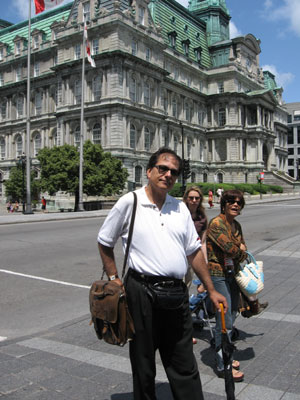
Our guide Louis in front of Montreal’s City Hall
The northeast end of Place Jacques Cartier is the location of Montreal’s City Hall, built in the Second Empire Style and opened in 1878. A fire destroyed the roof and the interior of the building in 1922 and the roof was reconstructed in 1926 along the lines of the city hall in Tours, France. Today, Montreal’s City Hall is still located in this historic building.
Place Jacques-Cartier was a fitting place to end our tour of Old Montreal and everyone in the crowd thanked Louis profusely for sharing his local insight and knowledge. By this time it was almost 1 pm, and my stomach was telling me what it was time for: lunch at the Café du Chateau.
Susanne Pacher is the publisher of Travel and Transitions (www.travelandtransitions.com), a popular web portal for unconventional travel & cross-cultural connections. Check out our brand new section featuring FREE ebooks about travel.
photo credit-www.travelandtransitions.com
